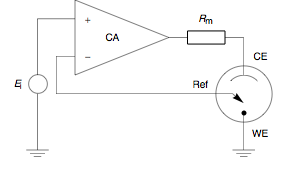
Back Potentiostat German Potenciostato Spanish Potentsiostaat Estonian پتانسیواستات Persian Potentiostat French Potentiostaat Dutch Potensiostat NB Potenciostato Portuguese Potențiostat Romanian

A potentiostat is the electronic hardware required to control a three electrode cell and run most electroanalytical experiments. A Bipotentiostat and polypotentiostat are potentiostats capable of controlling two working electrodes and more than two working electrodes, respectively.[1][2][3][4]
The system functions by maintaining the potential of the working electrode at a constant level with respect to the reference electrode by adjusting the current at an auxiliary electrode. The heart of the different potentiostatic electronic circuits is an operational amplifier (op amp).[5] It consists of an electric circuit which is usually described in terms of simple op amps.
- ^ Bard, A.J.; Faulkner, L.R. (2000). Electrochemical Methods: Fundamentals and Applications. New York: John Wiley & Sons, 2nd Edition, ISBN 0-471-40521-3.
- ^ Cynthia G. Zoski (Editor) (2007). Handbook of Electrochemistry. Elsevier, ISBN 0-444-51958-0
- ^ Peter T. Kissinger, William R. Heineman (1996). Laboratory Techniques in Electroanalytical Chemistry. CRC Press, ISBN 0-8247-9445-1
- ^ Douglas A. Skoog, F. James Holler, Timothy A. Nieman (1998). Principles of Instrumental Analysis. Harcourt Brace College Publishers,ISBN 0-03-002078-6.
- ^ W. Colburn, Alex; J. Levey, Katherine; O'Hare, Danny; V. Macpherson, Julie (2021). "Lifting the lid on the potentiostat: a beginner's guide to understanding electrochemical circuitry and practical operation". Physical Chemistry Chemical Physics. 23 (14): 8100–8117. Bibcode:2021PCCP...23.8100C. doi:10.1039/D1CP00661D. PMID 33875985.
© MMXXIII Rich X Search. We shall prevail. All rights reserved. Rich X Search